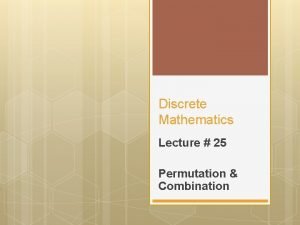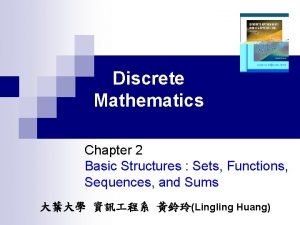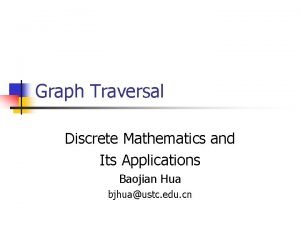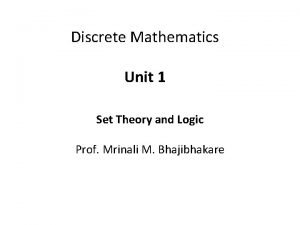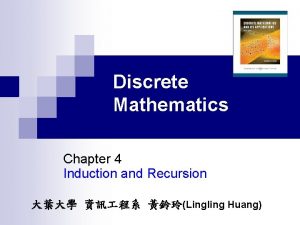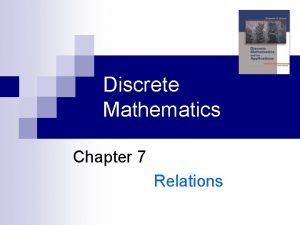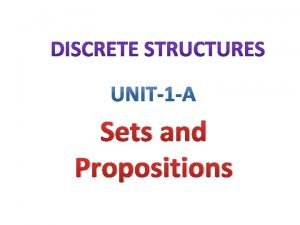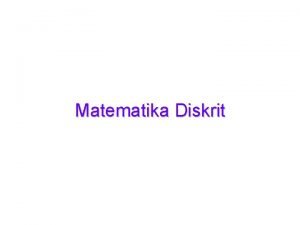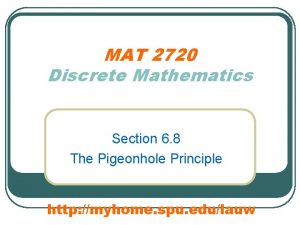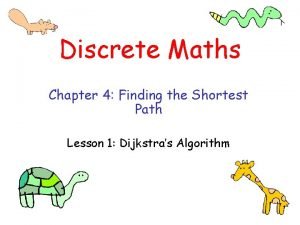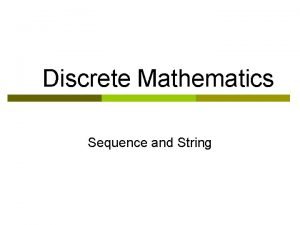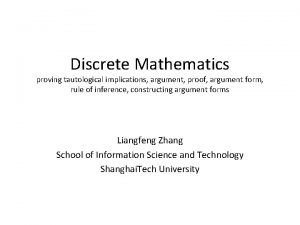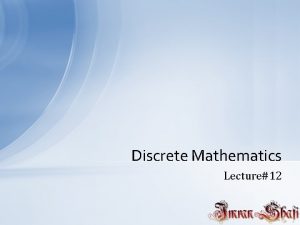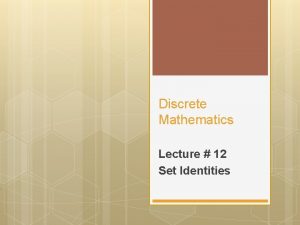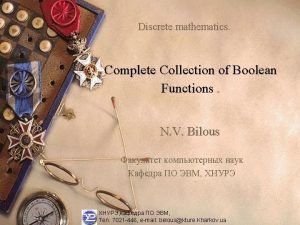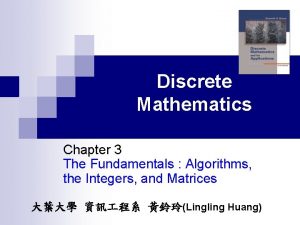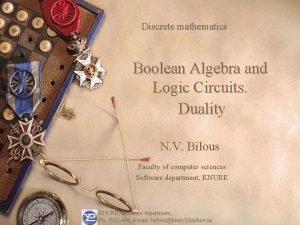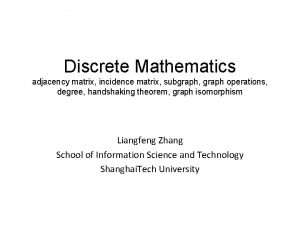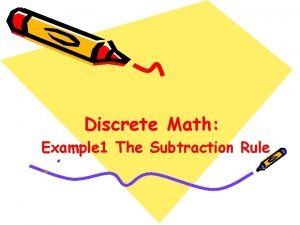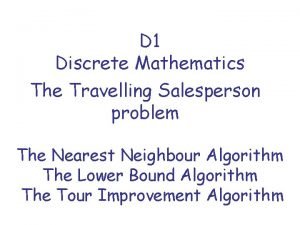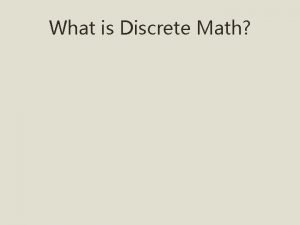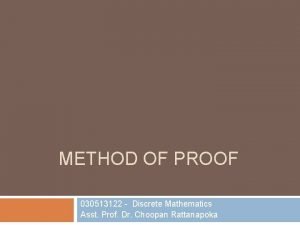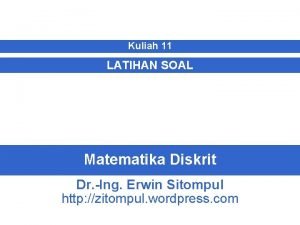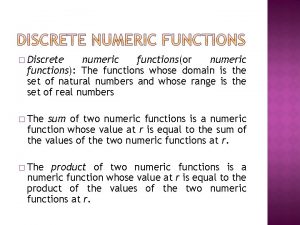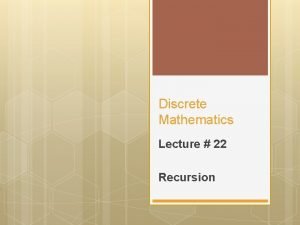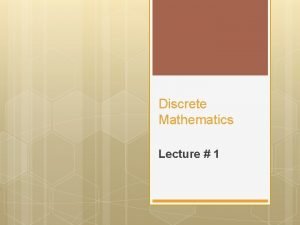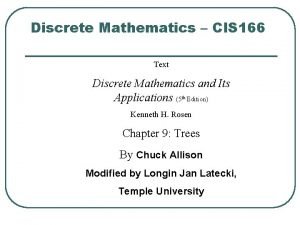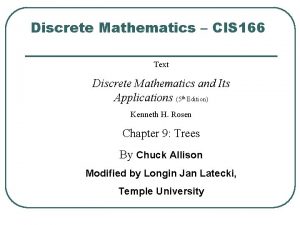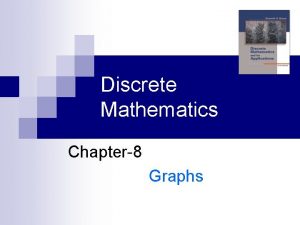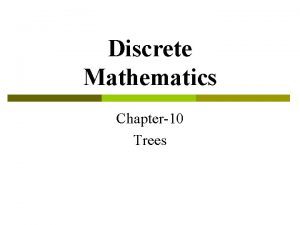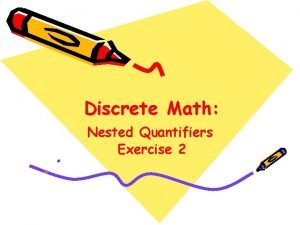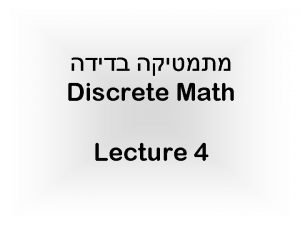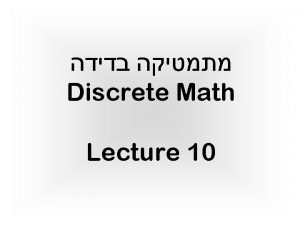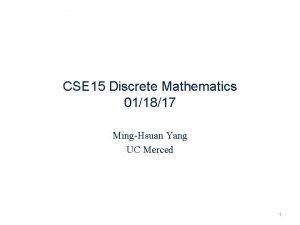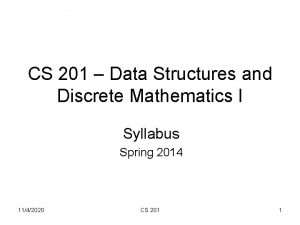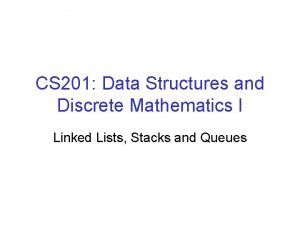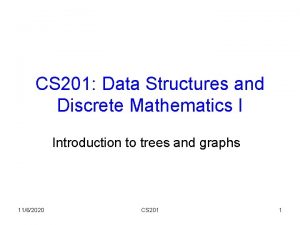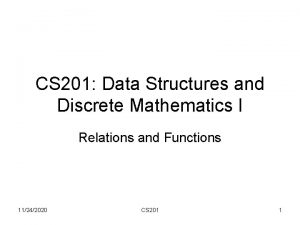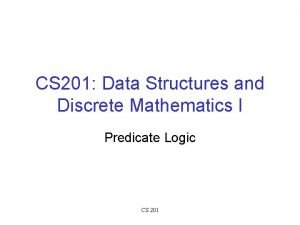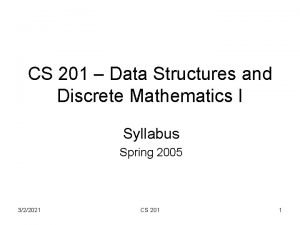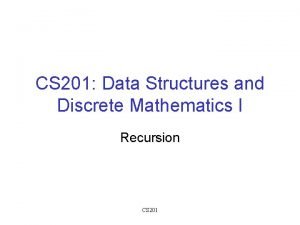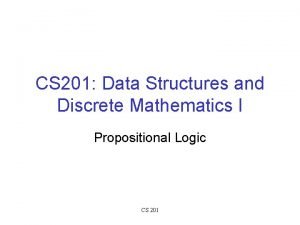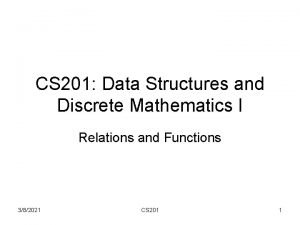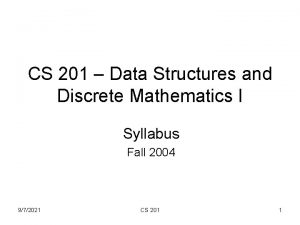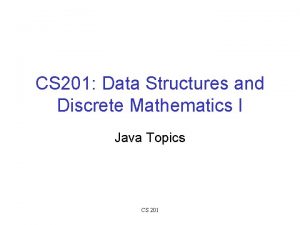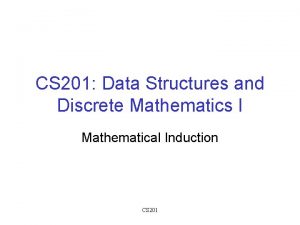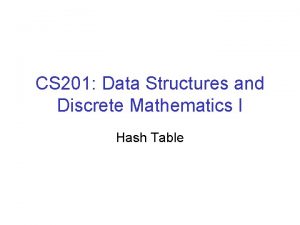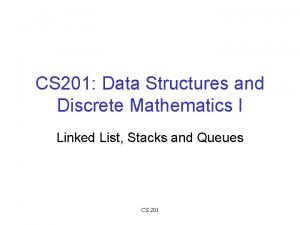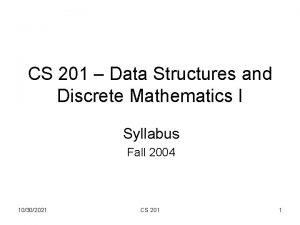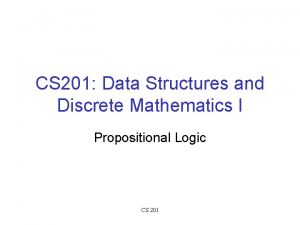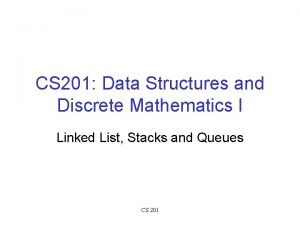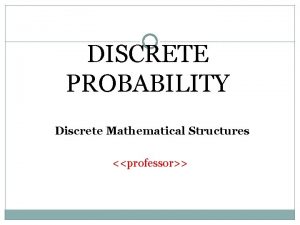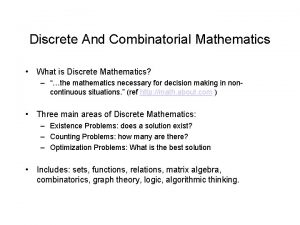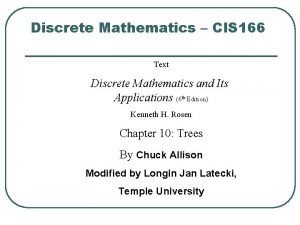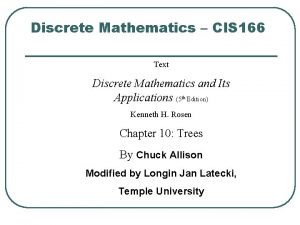CS 201 Data Structures and Discrete Mathematics I




























![Algebraic proof examples • Prove: [A (B C)] ([A’ (B C)] (B C)’) = Algebraic proof examples • Prove: [A (B C)] ([A’ (B C)] (B C)’) =](https://slidetodoc.com/presentation_image_h/e07b5cf5cd042b15c7f31aa40b42c093/image-29.jpg)









- Slides: 38

CS 201: Data Structures and Discrete Mathematics I Basic Set Theory 12/4/2020 CS 201 1

Sets • A set is a collection of distinct objects. • For example (let A denote a set): A = {apple, pear, grape} A = {1, 2, 3, 4, 5} A = {1, b, c, d, e, f} A = {(1, 2), (3, 4), (9, 10)} A = {<1, 2, 3>, <3, 4, 5>, <6, 7, 8>} A = a collection of anything that is meaningful. 12/4/2020 CS 201 2

Members and Equality of Sets • The objects that make up a set are called members or elements of the set. • Two sets are equal iff they have the same members. – That is, a set is completely determined by its members. – Order and repetition do not matter in a set. 12/4/2020 CS 201 3

Set notations • The notation of {. . . } describes a set. Each member or element is separated by a comma. – E. g. , S = {apple, pear, grape} – S is a set – The members of S are: apple, pear, grape • Order and repetition do not matter in a set. • The following expressions are equivalent: – {1, 3, 9} – {9, 1, 3} – {1, 1, 3, 3, 9} 12/4/2020 CS 201 4

The membership symbol and the empty set • The fact that x is a member of a set S can be expressed as – x S – Reads: • x is in S, or • x is a member of S, or • X belongs to S • An example, S = {1, 2, 3}, 1 S, 2 S, 3 S • The negation of is written as (is not in). • The empty set is a set without any element – Denoted by {} or – For any object x, x 12/4/2020 CS 201 5

Defining a Set by membership properties • Notation – S = {x T | P(x)} (or S = {x | x T and P(x)}) – The members of S are members of an already known set T that satisfy property P. • An example: – Let Z be the set of integers – Let Z+ be the set of positive integers. – Z+ = {x Z | x > 0} 12/4/2020 CS 201 6

Sets of numbers • Z = The set of all integers Z = {…, -2, -1, 0, 1, 2, …} • Z+ = The set of positive integers Z+ = {1, 2, 3…} = {x | x Z and x > 0} = {x Z | x > 0} • Z- = The set of negative integers Z- = {…, -3, -2, -1} = {-1, -2, -3…} = {x Z | x < 0} • R = The set of all real numbers • Q = the set of all rational numbers Q = {x R | x = p/q and p, q Z and q 0} • We can use “; ” to replace “and” 12/4/2020 CS 201 7

Subsets • A is a subset ( ) of B, or B is a superset of A iff every member of A is a member of B. – A B iff forall x if x A, then x B • An example: – (-2, 0, 6} {-3, -2, -1, 0, 1, 3, 6} • Negation: A is not a subset of B or B is not a superset of A iff there is a member of A that is not a member of B – A B iff there exist x, x A, x B 12/4/2020 CS 201 8

Obvious subsets –S S – S • By contradiction: • if S then there exist x, x and x S. 12/4/2020 CS 201 9

Proper subsets • A is a proper subset ( ) of B, or B is a proper superset of A iff A is a subset of B and A is not equal to B. – A B iff A B and A B • Examples: – {1, 2, 3} {1, 2, 3, 4, 5} – Z+ Z Q R – If S then S 12/4/2020 CS 201 10

Power sets • The set of all subsets of a set is called the power set of the set • The power set of S is denoted by P(S). • Example: – – P( ) ={ } P({1, 2}) = { , {1}, {2}, {1, 2}} P(S) = { , …, S} What is P({1, 2, 3})? • How many elements does the power set of S have? Assume S has n elements. 12/4/2020 CS 201 11

and are different • Examples: 1 {1} is true 1 {1} is false {1} is true • Which of the following statement is true? S P(S) 12/4/2020 CS 201 12

Mutual inclusion and set equality • Sets A and B have the same members iff they mutually include – A B and B A • That is, A = B iff A B and B A • Mutual inclusion is very useful for proving the equality of sets • To prove an equality, we prove two subset relationships. 12/4/2020 CS 201 13

An example: equality of sets • • Recall that Z = the set of (all) integers Let A = {x Z | x = 2 m for m Z } Let B = {x Z | x = 2 n-2 for n Z } To show A B, note that 2 m = 2(m+1) – 2 = 2 n-2 • To show that B A, note that 2 n-2=2(n-1) = 2 m • That is, A = B. (A, B both denote the set of all even integers. 12/4/2020 CS 201 14

Universal sets • Depending on the context of discussion – Define a set of U such that all sets of interest are subsets of U. – The set U is known as a universal set • Examples: – When dealing with integers, U may be Z. – When dealing with plane geometry, U may be the set of points in the plane 12/4/2020 CS 201 15

Venn diagram • Venn diagram is used to visualize relationships of some sets. • Each subset (of U, the rectangle) is represented by a circle inside the rectangle. 12/4/2020 CS 201 16

Set operations • Let A, B be subsets of some universal set U. • The following set operations create new sets from A and B. • Union: A B = {x U | x A or x B} • Intersection: A B = {x U | x A and x B} • Difference: A B = A B= {x U | x A and x B} • Complement A = U A = {x U | x A} 12/4/2020 CS 201 17

Set union • An example {1, 2, 3} {1, 2, 4, 5} = {1, 2, 3, 4, 5} The venn diagram 3 12/4/2020 1 5 2 4 CS 201 18

Set intersection • An example {1, 2, 3} {1, 2, 4, 5} = {1, 2} The venn diagram 3 12/4/2020 1 5 2 4 CS 201 19

Set difference • An example {1, 2, 3} - {1, 2, 4, 5} = {3} The venn diagram 3 12/4/2020 1 5 2 4 CS 201 20

Set complement • The venn diagram 12/4/2020 CS 201 21

Some questions • Let A B. – What is A – B? – What is B – A? – If A, B C, what can you say about A B and C? – If C A, B, what can you say about C and A B? 12/4/2020 CS 201 22

Basic set identities (equalities) • Commutative laws A B=B A • Associative laws (A B) C = A (B C) • Distributive laws A (B C) = (A B) (A C) 12/4/2020 CS 201 23

Basic set identities (cont …) • Identity laws A=A =A A U=U A=A • Double complement law (A’)’ = A • Idempotent laws A A=A • De Morgan’s laws (A B)’ = A’ B’ 12/4/2020 CS 201 24

Basic set identities (cont …) • Absorption laws A (A B) = A • Complement law (U)’ = U • Set difference law A – B = A B’ • Universal bound law A U=U A = 12/4/2020 CS 201 25

Proof methods • There are many ways to prove set identities • The methods include – Applying existing identities – Using mutual inclusion • Prove (A B) C = A (B C) using mutual inclusion – First show: (A B) C A (B C) – Let x (A B) and x C • (x A and x B) and x C • x A and x (B C) • x A (B C) – Then show that A (B C) (A B) C 12/4/2020 CS 201 26

More proof examples • Let B = {x | x is a multiple of 4} A = {x | x is a multiple of 8} Then we have A B • Proof: let x A. We must show that x is a multiple of 4. We can write x = 8 m for some integer m. We have – x = 8 m = 2*4 m = 4 k, where k = 2 m, – so k is a integer. – Thus, x is a multiple of 4, and • therefore x B 12/4/2020 CS 201 27

More proof examples • Prove {x | x Z and x 0 and x 2 < 15} = {x | x Z and x 0 and 2 x < 7} Proof: Let A = {x | x Z and x 0 and x 2 < 15} B = {x | x Z and x 0 and 2 x < 7} Let x A. x can only be 0, 1, 2, 3 2 x for 0, 1, 2, 3 are all less then 7. Thus, A B. Likewise, we can also show that B A 12/4/2020 CS 201 28
![Algebraic proof examples Prove A B C A B C B C Algebraic proof examples • Prove: [A (B C)] ([A’ (B C)] (B C)’) =](https://slidetodoc.com/presentation_image_h/e07b5cf5cd042b15c7f31aa40b42c093/image-29.jpg)
Algebraic proof examples • Prove: [A (B C)] ([A’ (B C)] (B C)’) = Proof: [A (B C)] ([A’ (B C)] (B C)’) = ([A (B C)] [A’ (B C)]) (B C)’ (associative) = ([(B C) A] [(B C) A’]) (B C)’ (commutative) = [(B C) (A A’)] (B C)’ (distributive) = [(B C) ] (B C)’ (complement) = (B C)’ (Identity) = (identity) 12/4/2020 CS 201 29

Algebraic proof examples • Prove: (A B) – C = (A – C) (B – C) • Proof: (A B) – C = (A B) C’ (difference) = C’ (A B) (commutative) = (C’ A) (C’ B) (distributive) = (A C’) (B C’) (commutative) = (A – C) (B – C) (difference) 12/4/2020 CS 201 30

Disproving an alleged Set property • Is the following true? (A – B) (B – C) = A – C Solution: Draw a Venn diagram and construct some sets to confirm the answer Counterexample: A = {1, 2, 4, 5}, B = {2, 3, 5, 6}, and C = {4, 5, 6, 7} A – B = {1, 4}, B – C = {2, 3}, A – C = {1, 2} (A – B) (B – C) = {1, 2, 3, 4} 12/4/2020 CS 201 31

Pigeonhole principle • If more than k pigeons fly into k pigeonholes, then at least one hole will have more than one pigeon. • Pigeonhole principle: if more than k items are placed into k bins, then at least one bin contains more than one item. • Simple, and obvious!! • To apply it, may not be easy sometimes. Need to be clever in identifying pigeons and pigeonholes. 12/4/2020 CS 201 32

Example • How many people must be in a room to guarantee that two people have last names that begin with the same initial? 27 since we have 26 letters • How many times must a single die be rolled in order to guarantee getting the same value twice? 7 12/4/2020 CS 201 33

Another example • Prove that if four numbers are chosen from the set {1, 2, 3, 4, 5, 6}, at least one pair must add up to 7. Proof: There are 3 pairs of numbers from the set that add up to 7, i. e. , (1, 6), (2, 5), (3, 4) Apply pigeonhole principle: bins are the pairs, and the numbers are the items. 12/4/2020 CS 201 34

Infinite sets • In a finite set, we can always designate one element as the first member, s 1, another element as the second member, s 2 and so on. If there are k elements in the set we can list them as – s 1, s 2, …, sk • A set that is not finite is called a infinite set. • If a set is infinite, we may still be able to select a first element s 1, a second element s 2 and so on: – s 1, s 2, … – Such an infinite set is said to be denumerable. • Both finite and denumerable sets are countable. • Countable does not mean we can give a total number, but means that we can say, “here is the first one” and “here is the second one” and so on. 12/4/2020 CS 201 35

Countable sets: examples • The set of positive integer numbers are countable. • To prove it, we need to give a counting scheme, in this case, 1, 2, 3, 4, …. • The set of positive rational numbers are countable 1/1 1/2 1/3 1/4 … 2/1 2/2 2/3 2/4… 3/1 3/2 3/3 3/4 … 12/4/2020 CS 201 36

Uncountable sets • There also some sets that are uncountable. – The set is so large, and there is no way to count out the elements. • One example: The set of real numbers between 0 and 1 is uncountable. • A computer can only manage finite sets. 12/4/2020 CS 201 37

Summary • Sets are extremely important for Computer Science. • A set is simply an unordered list of objects. • Set operations: union, intersection, difference. • To prove set equalities – Applying existing identities – Using mutual inclusion • Pigeonhole principle 12/4/2020 CS 201 38
 Permutation and combination in discrete mathematics
Permutation and combination in discrete mathematics Onto function definition
Onto function definition Graph traversal in discrete mathematics
Graph traversal in discrete mathematics Idempotent law truth table
Idempotent law truth table Induction and recursion discrete mathematics
Induction and recursion discrete mathematics Antisymmetric closure
Antisymmetric closure Sets and propositions in discrete mathematics
Sets and propositions in discrete mathematics Kenneth rosen discrete mathematics solutions
Kenneth rosen discrete mathematics solutions Pigeonhole principle in discrete mathematics
Pigeonhole principle in discrete mathematics Logical equivalence in discrete mathematics
Logical equivalence in discrete mathematics Kesetaraan logis adalah
Kesetaraan logis adalah Shortest path problem in discrete mathematics
Shortest path problem in discrete mathematics Sequence discrete math
Sequence discrete math Tautological implications
Tautological implications Inverse relation
Inverse relation Logical equivalence table
Logical equivalence table Discrete math set identities
Discrete math set identities Boolean function in discrete mathematics
Boolean function in discrete mathematics Counting techniques in discrete mathematics
Counting techniques in discrete mathematics Discrete mathematics chapter 3 solutions
Discrete mathematics chapter 3 solutions Site:slidetodoc.com
Site:slidetodoc.com Duality in discrete mathematics
Duality in discrete mathematics Incidence matrix in discrete mathematics
Incidence matrix in discrete mathematics Product rule discrete math
Product rule discrete math Travelling salesman problem discrete mathematics
Travelling salesman problem discrete mathematics What is discrete mathematics
What is discrete mathematics Methods of proof in discrete mathematics
Methods of proof in discrete mathematics Contoh soal relasi matematika diskrit
Contoh soal relasi matematika diskrit The domain of discrete numeric function is
The domain of discrete numeric function is Recursion discrete math
Recursion discrete math Compound statement symbols
Compound statement symbols M ary tree in discrete mathematics
M ary tree in discrete mathematics M ary tree in discrete mathematics
M ary tree in discrete mathematics Connected simple graph
Connected simple graph What is rooted tree in discrete mathematics
What is rooted tree in discrete mathematics Nested quantifiers exercises
Nested quantifiers exercises A. 1 b. 2 c. 3 d. 4
A. 1 b. 2 c. 3 d. 4 Total order
Total order Discrete mathematics
Discrete mathematics
